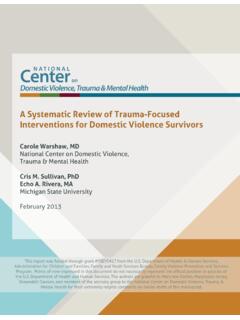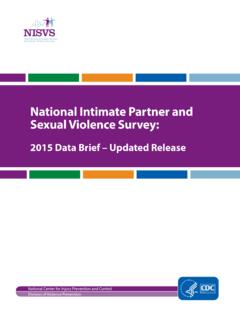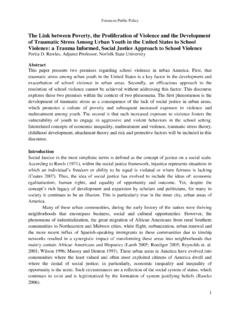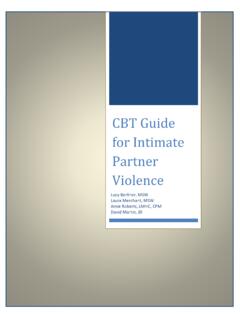Transcription of Controlling or Coercive Behaviour in an Intimate or Family ...
1 Controlling or Coercive Behaviour in an Intimate or Family Relationship Statutory Guidance Framework December 2015 2 Section 1 Status and purpose of this document Introduction 1. The Serious Crime Act 2015 (the 2015 Act) received royal assent on 3 March 2015. The Act creates a new offence of Controlling or Coercive Behaviour in Intimate or familial relationships (section 76). The new offence closes a gap in the law around patterns of Controlling or Coercive Behaviour in an ongoing relationship between Intimate partners or Family members. The offence carries a maximum sentence of 5 years imprisonment, a fine or both. 2. This guidance is issued as statutory guidance under section 77 of the 2015 Act.
2 A person investigating offences in relation to Controlling or Coercive Behaviour under section 76 must have regard to it. 3. This offence is constituted by Behaviour on the part of the perpetrator which takes place repeatedly or continuously . The victim and alleged perpetrator must be personally connected at the time the Behaviour takes place. The Behaviour must have had a serious effect on the victim, meaning that it has caused the victim to fear violence will be used against them on at least two occasions , or it has had a substantial adverse effect on the victims day to day activities . The alleged perpetrator must have known that their Behaviour would have a serious effect on the victim, or the Behaviour must have been such that he or she ought to have known it would have that effect.
3 4. Controlling or Coercive Behaviour should be dealt with as part of adult and/or child safeguarding and public protection procedures. Audience 5. This guidance is for the police and criminal justice agencies involved in the investigation of offences. 6. The information within this guidance may also be relevant to assist the work of non-governmental organisations and voluntary organisations. 7. This guidance extends to England and Wales only. Aims of the guidance 8. This guidance provides information on: identifying domestic violence , domestic abuse and Controlling or Coercive Behaviour ; circumstances in which the new offence might apply; the types of evidence for the offence; the defence.
4 3 Section 2 The offence of Controlling or Coercive Behaviour The rationale for the offence 9. The offence closes a gap in the law around patterns of Controlling or Coercive Behaviour that occurs during a relationship between Intimate partners, former partners who still live together or Family members. This offence sends a clear message that this form of domestic abuse can constitute a serious offence particularly in light of the violation of trust it represents and will provide better protection to victims experiencing repeated or continuous abuse . It sets out the importance of recognising the harm caused by coercion or control, the cumulative impact on the victim and that a repeated pattern of abuse can be more injurious and harmful than a single incident of violence .
5 Understanding Controlling or Coercive Behaviour 10. Controlling or Coercive Behaviour does not relate to a single incident, it is a purposeful pattern of Behaviour which takes place over time in order for one individual to exert power, control or coercion over another. 11. This new offence focuses responsibility and accountability on the perpetrator who has chosen to carry out these behaviours . 12. The cross-Government definition of domestic violence and abuse1 outlines Controlling or Coercive Behaviour as follows: Controlling Behaviour is: a range of acts designed to make a person subordinate and/or dependent by isolating them from sources of support, exploiting their resources and capacities for personal gain, depriving them of the means needed for independence, resistance and escape and regulating their everyday Behaviour .
6 Coercive Behaviour is: a continuing act or a pattern of acts of assault, threats, humiliation and intimidation or other abuse that is used to harm, punish, or frighten their victim. 2 1 The definition is supported by the following explanatory text: This definition, which is not a legal definition, includes so called 'honour' based violence , female genital mutilation (FGM) and forced marriage, and is clear that victims are not confined to one gender or ethnic group. 2 The cross-government definition of domestic violence and abuse is not a legal definition and includes so called honour based violence , female genital mutilation (FGM) and forced marriage, and is clear that victims are not confined to one gender or ethnic group.
7 Not only is Coercive control the most common context in which [women] are abused, it is also the most dangerous Evan Stark (2007) Coercive Control. How Men Entrap Women in Personal Life. New York: Oxford University Press. 4 13. Controlling or Coercive Behaviour does not only happen in the home, the victim can be monitored by phone or social media from a distance and can be made to fear violence on at least two occasions or adapt their everyday Behaviour as a result of serious alarm or distress. Types of Behaviour The types of Behaviour associated with coercion or control may or may not constitute a criminal offence in their own right. It is important to remember that the presence of Controlling or Coercive Behaviour does not mean that no other offence has been committed or cannot be charged.
8 However, the perpetrator may limit space for action and exhibit a story of ownership and entitlement over the victim. Such behaviours might include: isolating a person from their friends and Family ; depriving them of their basic needs; monitoring their time; monitoring a person via online communication tools or using spyware; taking control over aspects of their everyday life, such as where they can go, who they can see, what to wear and when they can sleep; depriving them of access to support services, such as specialist support or medical services; repeatedly putting them down such as telling them they are worthless; enforcing rules and activity which humiliate, degrade or dehumanise the victim.
9 Forcing the victim to take part in criminal activity such as shoplifting, neglect or abuse of children to encourage self-blame and prevent disclosure to authorities; financial abuse including control of finances, such as only allowing a person a punitive allowance; threats to hurt or kill; threats to a child; threats to reveal or publish private information ( threatening to out someone). assault; criminal damage (such as destruction of household goods); rape; preventing a person from having access to transport or from working. This is not an exhaustive list 5 Where the offence applies 14. For the offence to apply: The Controlling or Coercive Behaviour must take place repeatedly or continuously.
10 Continuously means on an ongoing basis. This could mean, but is not limited to, actions which cause the victim to change their way of living. Behaviour displayed on only one occasion would not amount to repeated or continuous Behaviour and courts may look for evidence of a pattern of Behaviour established over a period of time rather than, for example, one or two isolated incidents which do not appear to establish a pattern. However, each case must be considered on an individual basis, there is no set number of incidents in which Controlling or Coercive Behaviour has been displayed which must be proved. As much evidence as possible must be gathered to show that the Behaviour is of a repetitive or continuous nature.
















